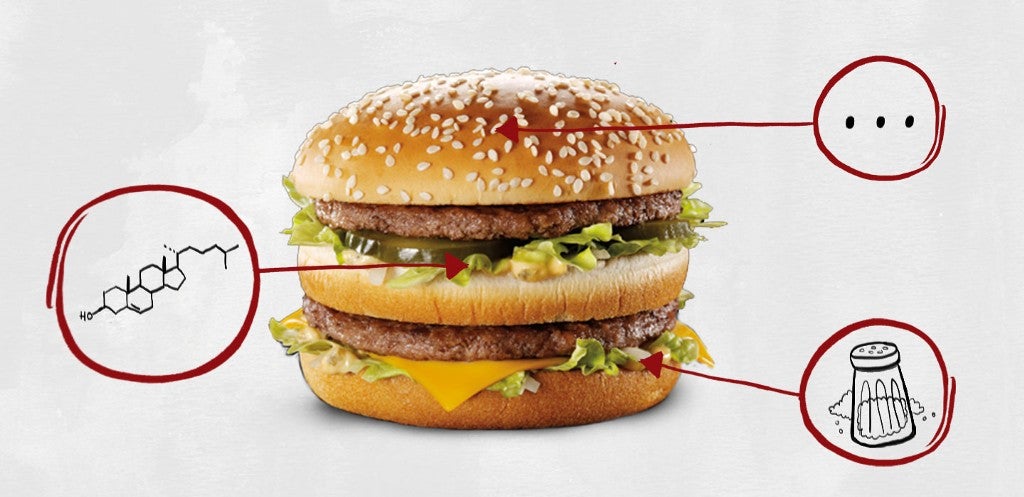We’re often told that you should never eat anything if you don’t recognize everything on the ingredients list. But since most of us have no idea what xanthan gum and potassium benzoate are — or more importantly, what they’re doing to our bodies — we’re decoding the ingredients in the many things Americans put in (and on) themselves with the help of an expert. This edition: McDonald’s Big Mac, which is made from more than 60 ingredients (some of which have ingredients lists of their own) that we’ve broken down in the exact order they appear on their website.

The Big Mac Bun
1) Enriched Flour (Wheat Flour, Malted Barley Flour, Niacin, Iron, Thiamine Mononitrate, Riboflavin, Folic Acid): To make white bread, you need white flour. To make white flour, two of the three layers that make up a grain of wheat (bran and germ) are removed along with the iron and B vitamins (folic acid, riboflavin, niacin and thiamine) they contain. The good news? This increases the flour’s shelf life and is a main reason why Big Macs pretty much never go bad. The bad news? It strips away much of what technically made this “food.”
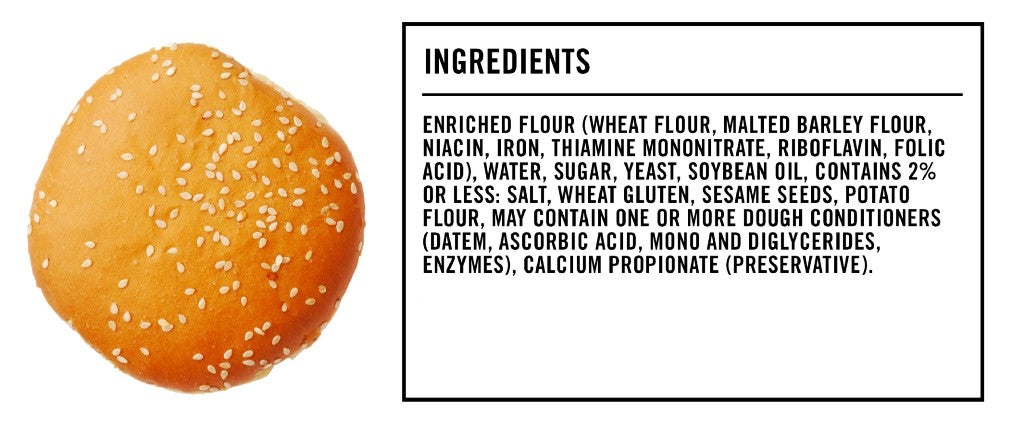
The remaining layer of grain — endosperm — is then ground into a yellowish flour, which is treated with bleaching agents like chlorine or benzoyl peroxide to give it a pure white hue. Because many of the ingredients are either lost or destroyed during this process, the flour is then enriched with B vitamins, iron and sometimes calcium — thus, “enriched flour.”
In addition to containing more calories than unbleached whole wheat flour, the bleaching process presents an unfortunate byproduct: A chemical called alloxan, which is used to induce diabetes in lab-animal test subjects by destroying their pancreas. In other words, if you have a family history of diabetes or disorders of the pancreas, triple-decker Big Mac buns may just be your mortal enemy.
2) Water: Good ol’ H20.
3) Sugar: In addition to adding sweetness (obviously), sugar reduces the time it takes for dough to rise, which is important when you’re slinging Big Macs (and their three buns) at a ludicrous speed day in and day out.
4) Yeast: The fungus that makes dough rise.
5) Soybean Oil: According to physician and biochemist Cate Shanahan, author of Deep Nutrition: Why Your Genes Need Traditional Food, soybean oil is the most abundant of vegetable oils. Consuming too much of it — which is easy to do, considering Shanahan says roughly 45 percent of the average American’s calories come from refined oils — has serious repercussions (e.g., fatty liver disease and migraines), as we learned in our exploration of all 26 ingredients in nacho-flavored Doritos.
6) Salt: A single Big Mac contains 950 milligrams of salt, or about 40 percent of the American Heart Association’s daily recommended intake — not surprising since salt can be found in the bun, the sauce, the cheese, the patty and the pickle slices.
7) Wheat Gluten: Those with celiac disease beware: Wheat gluten is wheat flour that’s been hydrated to activate the gluten, then processed to remove everything except the gluten. It’s added to improve the chewiness of the bun.
8) Sesame Seeds: The crunchy seeds found atop many hamburger buns.
9) Potato Flour: Potato flour attracts and holds water, which adds a moist chewiness to the bun.
10) May Contain One or More Dough Conditioners (DATEM, Ascorbic Acid, Mono and Diglycerides, Enzymes): Any ingredient or chemical added to improve the texture or quality of dough is classified as a dough conditioner. While some aren’t as sketchy as they sound — ascorbic acid is just another form of vitamin C — some are downright devious. Mono and diglycerides, for example, may be packed with trans fats that aren’t listed on the label. Because trans fats are associated with an increased risk of heart disease, stroke and diabetes, consuming more than you think you are (because they weren’t listed on the label) could do serious damage to your body.
DATEM (diacetyl tartaric acid esters of monoglycerides) is another potentially harmful dough conditioner, since it’s been found to cause heart problems in lab animals. Whether or not it should be a real point of concern for consumers, however, is still up for debate.
11) Calcium Propionate (Preservative): Another contributor to the Big Mac’s seemingly interminable shelf-life, calcium propionate is an antifungal added to many bread products to prevent mold growth. In addition to being linked to migraines, a 2002 study in the Journal of Paediatric Child Health found that chronic exposure to calcium propionate in children caused irritability, restlessness, inattention and sleep disturbance. So for the sake of your kids’ health and your sleep schedule, keep their Big Mac intake to a minimum.

The Beef Patties
1) 100 Percent Pure USDA Inspected Beef Prepared with Grill Seasoning (Salt and Black Pepper): Despite the pink slime scare of recent years, McDonald’s hamburger patties in the U.S. are currently made with 100-percent USDA-inspected beef and contain no fillers, extenders or preservatives.
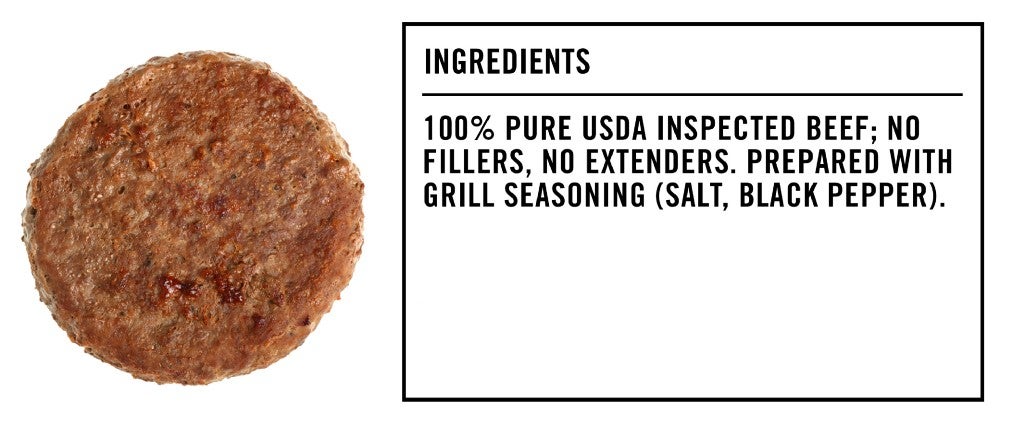

Shredded Lettuce
1) Lettuce: Surprise! It’s iceberg lettuce, shredded.

Big Mac Sauce
1) Soybean Oil: Revisit “The Big Mac Bun” section if you’d like to re-experience how horrible soybean oil is for your body.
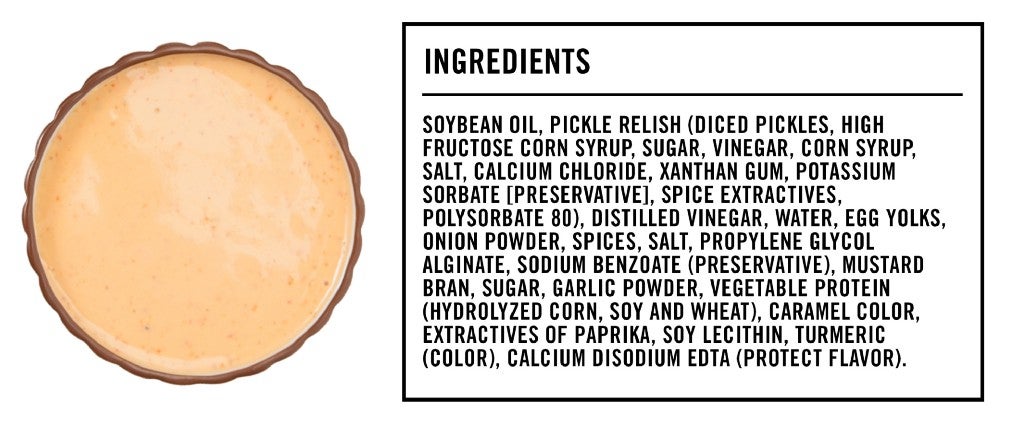
2) Pickle Relish (Diced Pickles, High Fructose Corn Syrup, Sugar, Vinegar, Corn Syrup, Salt, Calcium Chloride, Xanthan Gum, Potassium Sorbate [Preservative], Spice Extractives, Polysorbate 80): The Big Mac’s pickle relish contains a few questionable ingredients. High-fructose corn syrup, a commonly used sweetener, has been linked to obesity and diabetes in many, many studies. Polysorbate 80, which gives sauces their saucy texture, promotes inflammatory bowel disease and a cluster of obesity-related diseases known as metabolic syndrome, according to a 2015 study published in the journal Nature. Finally, the widely used preservative potassium sorbate damages DNA when exposed to human blood cells, according to a 2010 study published in Toxicology in Vitro; however, there have not yet been long-term studies on the effects of regular consumption.
You might be glad to discover that the other scary-sounding ingredients that make up the pickle relish aren’t all that scary. Calcium chloride, which helps pickles taste salty without actually adding salt, is safe for consumption, according to the FDA, so it’s really just a means of regulating sodium intake (which, as we’ve discussed, is important when eating a sodium-laden Big Mac). Xanthan gum is another relatively harmless ingredient that contributes to the texture of sauce; that said, those with bowel issues should keep an eye out for this ingredient, as a study published in the British Journal of Nutrition found it to be a highly efficient laxative.
3) Distilled Vinegar: Vinegar produced from the fermentation of distilled alcohol.
4) Water: More H20.
5) Egg Yolks: You know what egg yolks are, right?
6) Onion Powder: Dehydrated, ground onion used for flavoring.
7) Spices: As we learned in our exploration of the ingredients in nacho-flavored Doritos, the FDA doesn’t require food labelers to list each spice by their specific name (as a means of protecting their recipes) as long as it follows their definition of the word “spice”:
“The term spice means any aromatic vegetable substance in the whole, broken, or ground form, except for those substances which have been traditionally regarded as foods, such as onions, garlic and celery; whose significant function in food is seasoning rather than nutritional; that is true to name; and from which no portion of any volatile oil or other flavoring principle has been removed.”
8) Salt: More salt. Mmm.
9) Propylene Glycol Alginate: A thickening agent added to ensure the sauce isn’t too watery. While it sounds like an ingredient that might do your body harm, it won’t — a study performed in 1991 found that consuming large amounts of propylene glycol alginate for 23 days caused no adverse dietary or physiological effects.
10) Sodium Benzoate (Preservative): Another preservative, sodium benzoate has been shown to exacerbate hyperactive behavior in young children, which could be why your kid swings around the PlayPlace like an enraged gorilla.
11) Mustard Bran: Mustard seed that’s been ground down to a fine powder.
12) Sugar: For sweetness.
13) Garlic Powder: Just plain ol’ dehydrated ground garlic.
14) Vegetable Protein (Hydrolyzed Corn, Soy and Wheat): Vegetable protein is a flavor enhancer produced by boiling corn, soy or wheat in hydrochloric acid, then neutralizing the solution with sodium hydroxide. The result is pure amino acids, which are often used to give processed foods a fuller flavor, similar to the way MSG is used.
15) Caramel Color: As we discovered in our exploration of the eight ingredients that make up Diet Coke, caramel coloring has a highly controversial byproduct called 4-methylimidazole (4-MEI): A 2007 study found that mice fed a diet of 4-MEI developed cancerous lung tumors as a result. The FDA quickly pushed back, noting that a human would have to consume more than 1,000 cans of soft drinks (which are notoriously high in caramel coloring) every day for two years to reach comparable levels of 4-MEI.
Who’s right is still unclear. More recent studies argue that levels of 4-MEI are, in fact, high enough in soda and consumed in sufficient quantities by Americans to increase the risk of developing cancer. Do you really have to worry about this in your smear of Big Mac sauce, though? Probably not.
16) Extractives of Paprika: An oil-soluble version of the common household spice used for flavoring and coloring.
17) Soy Lecithin: According to Gavin Lavi Sacks, associate professor and academic director of Cornell University’s Food Science & Technology at Geneva Program, soy lecithin is a component of fat used to keep the Big Mac sauce saucy by preventing the oils and water within it from separating.
18) Turmeric (Color): This is what gives the sauce its orange-ish color.
19) Calcium Disodium EDTA (Protect Flavor): Another preservative, calcium disodium EDTA “binds to metals like iron, which slows the rate of oxidation, and thus, the development of rancid aromas,” Sacks explains. Studies performed on animals have shown that sustained consumption of calcium disodium EDTA can cause essential mineral depletion. Human studies are still required to come to a real conclusion on whether or not we should be worried about this ingredient.

Pasteurized Process American Cheese
1) Milk: That stuff that comes from cows.
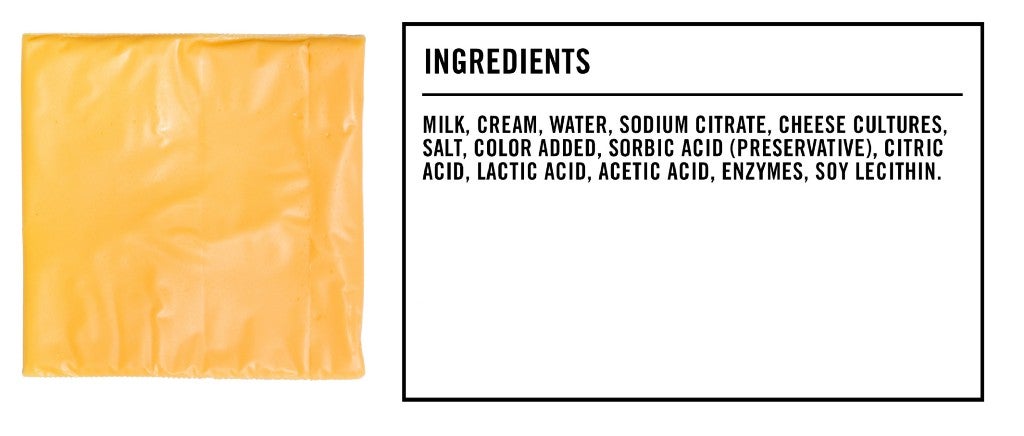
2) Cream: Cream is basically the fat-filled layer skimmed from the top of milk before homogenization.
3) Water: Plain, ol’ H20 — nothing to see here.
4) Sodium Citrate: Similar to calcium disodium EDTA, sodium citrate binds to metals and acts as a preservative. It also can be used to provide a sour taste.
5) Cheese Cultures: Single strains of bacteria used to ripen milk and begin the cheese-making process.
6) Salt: We told you there’d be a lot of salt.
7) Color Added: While certain artificial colors are known to be carcinogenic, Shanahan assures us that a normal person’s liver should have no problem breaking down whatever minuscule amounts of coloring we consume with our food.
8) Sorbic Acid (Preservative): Another preservative used for its antimicrobial properties, sorbic acid is on the FDA’s list of “generally recognized as safe,” or GRAS, substances.
9) Citric Acid: Citric acid is a sour flavoring agent derived from citrus. It’s also a mild preservative.
10) Lactic Acid: Lactic acid is a sugar added for acidic flavoring. It’s the main sugar in milk and can also be used to speed up the coagulation process of cheeses.
11) Acetic Acid: Acetic acid is the ingredient that gives vinegar its sour taste and pungent smell. It’s also a preservative used for its general antimicrobial properties, according to Sacks.
12) Enzymes: While discussing the ingredients in nacho-cheese Doritos, Shanahan explained to us that enzymes are just used to accelerate the coagulation process: “Pretty much all cheese is made using some kind of enzyme to speed up the fermentation process.”
13) Soy Lecithin: Soy lecithin is added as an emulsifier to give the cheese its texture.

Pickle Slices
1) Cucumbers: Not even McDonald’s can make pickles without cucumbers.
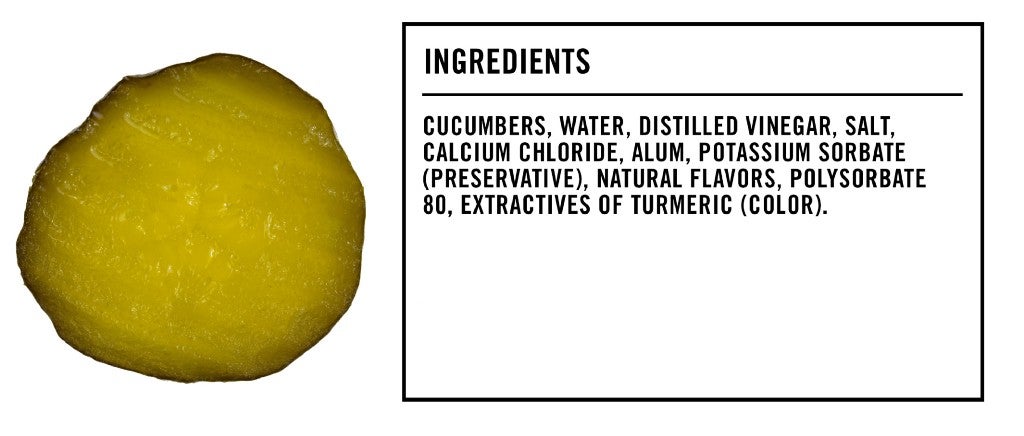
2) Water: You know this one.
3) Distilled Vinegar: Just in case you weren’t reading earlier, distilled vinegar is simply vinegar produced from the fermentation of distilled alcohol.
4) Salt: Salt… everywhere.
5) Calcium Chloride: Again, calcium chloride is a preservative often added to pickles to provide that salty taste without actually adding even more salt.
6) Alum: Alum is a common spice used in pickling recipes to maintain the vegetables’ crispiness.
7) Potassium Sorbate (Preservative): Potassium sorbate prevents yeast and mold growth, according to Sacks.
8) Natural Flavors: Natural flavors are quite literally flavors derived from an actual food source — i.e., pickle flavoring taken from real pickles.
9) Polysorbate 80: Polysorbate 80 is another emulsifier, but remember: It causes a cluster of bowel-related problems.
10) Extractives of Turmeric (Color): This common household spice is probably added to give the pickles that orange, sauce-covered tint.

Onions
1) Onions: They’re onions.

The Takeaway
While there are quite a few potentially problematic ingredients found in the Big Mac — soybean oil, calcium propionate and polysorbate 80 chief among them — Sacks is more concerned about the burger’s nutritional facts than its specific ingredients. “Almost half of the day’s recommended sodium content, 25 percent of the day’s calories… and you haven’t even added in French fries or a soda,” he says. In other words, if you’re eating enough Big Macs to be worried about the ingredients in them, all that salt will probably cause your demise long before the polysorbate 80.
